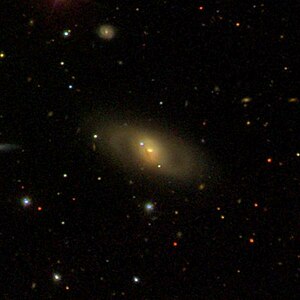NGC 6018
| Galaxy NGC 6018 |
|
|---|---|

|
|
| SDSS recording | |
| AladinLite | |
| Constellation | Snake |
|
Position equinox : J2000.0 , epoch : J2000.0 |
|
| Right ascension | 15 h 57 m 29.8 s |
| declination | + 15 ° 52 ′ 21 ″ |
| Appearance | |
| Morphological type | (R) SAB (s) 0+ |
| Brightness (visual) | 13.4 mag |
| Brightness (B-band) | 14.3 mag |
| Angular expansion | 1.4 ′ × 0.7 ′ |
| Position angle | 75 ° |
| Surface brightness | 13.3 mag / arcmin² |
| Physical data | |
| Affiliation | Abell 2147 |
| Redshift | 0.017405 ± 0.000083 |
| Radial velocity | (5218 ± 25) km / s |
|
Stroke distance v rad / H 0 |
(237 ± 17) · 10 6 ly (72.7 ± 5.1) Mpc |
| history | |
| discovery | Wilhelm Herschel |
| Discovery date | March 19, 1787 |
| Catalog names | |
| NGC 6018 • IC 1150 • UGC 10101 • PGC 56481 • CGCG 108-016 • MCG + 03-41-06 • IRAS 15551 + 1600 • 2MASX J15572978 + 1552213 • GC 4151 • H III 646 • h 1942 • | |
NGC 6018 is a 13.4 mag bright, lens-shaped galaxy of the Hubble-type S0-a in the constellation Snake near the celestial equator . It is an estimated 241 million light years from the Milky Way. Together with NGC 6021, the galaxy forms an optical double galaxy and was discovered on March 19, 1787 by Wilhelm Herschel with an 18.7-inch reflector telescope, who described it as “vF, S, lE”.
Most likely, NGC 6018 is identical to IC 1150 . It is the only object in this region to which the observation by Stéphane Javelle in July 1891 applies (with a positional error) .
